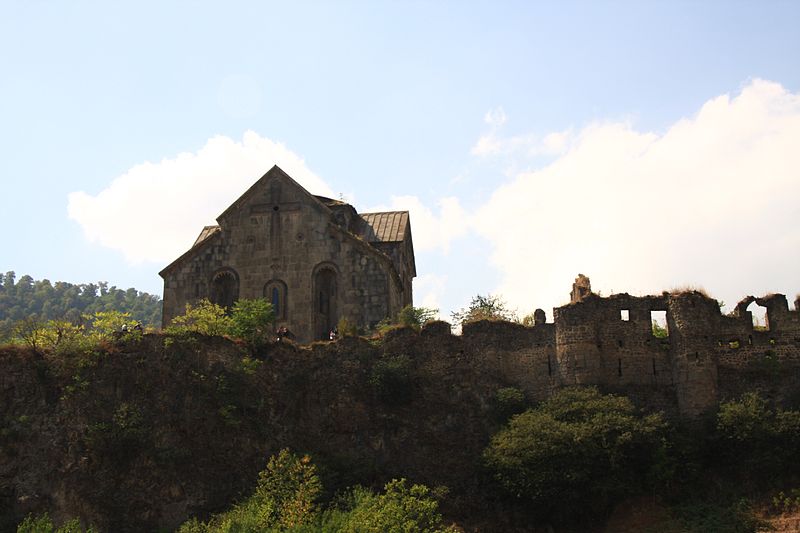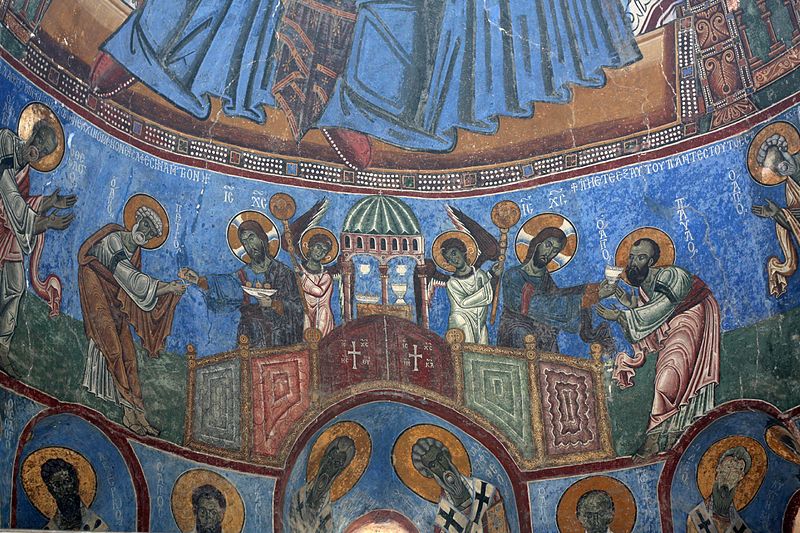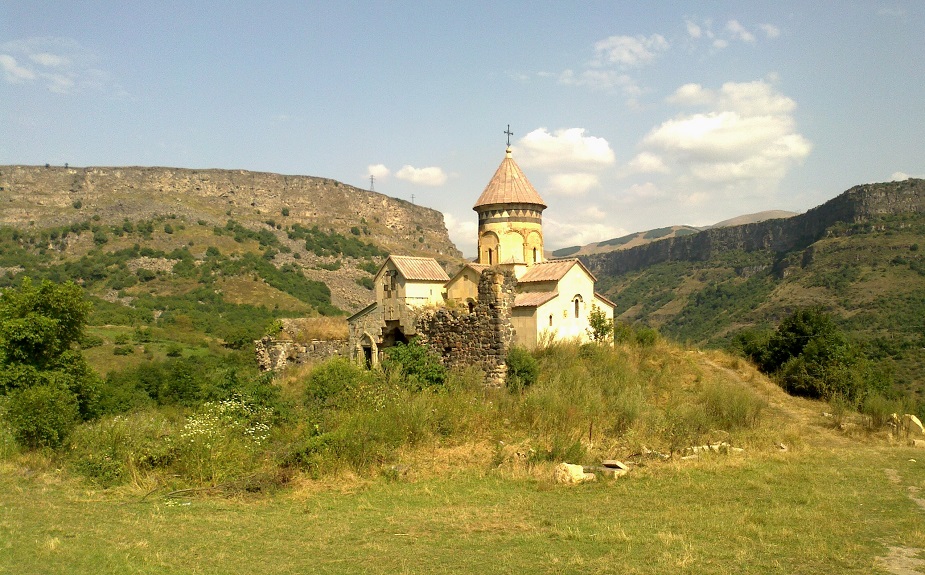ANALYTICS
29.03.23 12:00

As a result of occupation of independent Georgia by 11th Red Army (25.02.1921) by the resolution of Communist Party (Bolsheviks) Central Committee of the Caucasian Bureau of July 17, 1921 the age-old Georgian lands in the southern part of historical Kvemo Kartli - Lore region, covering 2478 sq km - were given to the Armenian Soviet Socialist Republic.
This region, the present-day northern part of Armenia - (Lori and partly Tavush provinces), is full of monuments of Georgian architecture. There are especially many monastic and church buildings of the twelfth and thirteenth centuries. But only three monuments are discussed in this article, among which the Akhtala monastery complex stands out. Akhtala, or new Armenian name Ptghakhank, is located in the gorge of the Debeda River, 20 km from the Georgian-Armenian state border.
The site is also known for its copper mines. There are 4 churches in the monastery and its surroundings. The main church of the Virgin Mary is located on a rocky plateau enclosed by the ruins of a fortress wall. A once majestic grey stone structure with a collapsed dome is visible from the western entrance. Vakhushti Batonishvili (Bagrationi), a famous Georgian historian and geographer of XVIII century (Editor) believed, that the church of Virgin Mary was erected by Vakhtang Gorgasali (Iberian tsar, one of the founders of the Georgian statehood and founder of Tbilisi - ed.) as a country bishop church.

Due to information of XIII century Armenian historian Kirakos Gandzaketsi Ivano Mkhargdzeli died in 1227 and was buried in Ptghakhanka (Akhtala), at the entrance of the church built by him. In fact, there is a small chapel adjoining the western vestibule of the church in Akhtala, which is the burial vault of Ivane Mkhargrdzeli and his son Avagi (+1250).
However, let us return to the main temple of Akhtala monastery complex, which was erected at the beginning of the XIII century. All four facades of the temple are decorated with monumental crosses, which is a typical decoration of Georgian architecture of XII-XIII centuries - Georgian temples of this period: Ikorta, Betania, Kvatakhevi, Fitareti, Khujabi and so on.
Such a facade monumental cross is first encountered on the east wall of the Samtavisi Episcopal Church (1030). The architect and bishop of Samtavisi was Illarion Kanchaveli, who "leaned" this huge cross, the True Cross, against the joint axis and placed it above the altar opening. On the same facade, two smaller crosses represent Calvary, where the crosses to crucify the Saviour and the criminals were placed; and the rhombuses at the bottom of the joint axis - the symbol of immortality and eternity - give a special semantic meaning to this monumental Life-Giving Cross.
Only a slightly simplified composition is presented on the east façade of the main temple of the Akhtala monastery. Here too, the junction axis is outlined by two huge rhombuses, then outlines the inlaid chancel aperture and frames the huge cross. Unlike Samtavisi, smaller crosses are not represented here. The edges of the church gates and apertures are generously decorated with inlays, where different variations of stylized plant ornaments in the form of various leaves and stems dominate, which belongs to the Georgian art of stone carving.
The main temple of the Virgin Mary is a cross-winged-dome building. Architecturally it belongs to the Betania, Kvatakhevi and Fitareti group of domed churches and it is the largest structure among them. The unexisting dome of the temple was supported by the pre-apsed pilasters on the altar and the two octagonal columns on the west. The temple amazes with magnificent wall art. The frescoes have an azure background which is reminiscent of the famous murals in Kintsvi monastery (Shida Kartli). The frescoes are described in Georgian language. In the altar apse the inscriptions are in Greek.
The conch depicts the Virgin Mary with the Child Jesus on the throne, below her the complete composition of the Communion of the Sacraments, a copy of the composition (1929) is by the famous artist Tatiana Shevyakova and is kept in the Sh. Amiranashvili Museum of Art of the National Museum of Georgia. Beneath the scene of the Communion in two registers are the saints of the Church, including St. Gregory of Parthia, the Illuminator of Armenia. The Orthodox Church commemorates St. Gregory the Martyr on September 30 (October 13th A.D.). The image of St. Gregory among the most venerated saints of the Orthodox Church is a sign of respect of the Georgian monks for their orthodox Armenian brothers, whose church language was Georgian, who worshipped side by side with them.

The lower part of the western wall of the church depicts the Illuminator of Georgia, St Nina of the Equal Apostles, as well as the great Georgian saints who founded the monastic life of Georgia: Johan Zedazeni, Shio Mghvimeli with his disciple Evagre, Hilarion of Georgia, Ekvtime and George Mtatsmindeli (Mount Athos).
The wall paintings of Akhtala date back to the 13th century and clearly bear the traces of the work of several painters painting at different times. The oldest layer, the painting of the lower register of the southern and northern side churches, belongs to the 1st half of the XIII century. The middle period of the XIII century belongs to the painting of the altar apse, the upper register of the southern and northern side churches and the western side chapel of the church was painted in the second half of the XIII century.

Stone gravestones with worn-out Georgian script of XIX century have been preserved on the floor of Akhtala Church of Holy Virgin. Since the middle of XIX century the inscriptions on the tombstones are also found in Russian. The subtle inscriptions on the marble slabs, made in the Georgian alphabet "mkhedruli", attract attention. Epitaphs mostly mention local Princes Melikishvili and their wives: Tamar Mzechabukovna Javakhishvili (+1802) - wife of Teimuraz Melikishvili, Princess Tamar Melikishvili-Cholokashvili (+1885), Ensign Alexander Iosifovich Melikishvili (+1847), Prince Nikolay Ivanovich Melikishvili (+1894), George Davidovich Gogoberidze (+1893) and others.
In the same church there is a stone with a relief image of the Cross and a six-line XIII century inscription in "asomtavruli" alphabet on the arms of the Cross: "Strength of Christ to the builders of this place: Demeter, George and Svimeon, forgive them their sins, Lord".
In the monastery, to the north-east of the Church of the Blessed Virgin Mary a few meters away, there is a large refectory with an ornamented entrance door on the first floor of the southern wall. In the south-western part is a hall church, the architecture and decoration of which is purely Georgian and dates back to the XIII century. The church was restored from the outside and plastered on the inside in XIX century. The vestibule of the fence is a complex structure and is presumably part of the palace, of which a large oval hall with vaults has been preserved.
On the hill to the north of the monastery is a hall church in the name of the Apostles, above the western gate of which a ten-line inscription in the alphabet "asomtavruli" is engraved. The inscription mentions the abbot of Akhtala Patra, who built this chapel - the altar of Avag atabag with his own hand and with the help of his nephew Illarion. The inscription is dated 1242-1250. A cemetery was placed around this church. A surviving XIX century gravestone with an inscription in "mkhedruli" commemorates Dimitri Iordanovich's wife Mariam Aslanovna Kochlamazashvili, who was separated from her husband and six sons by this transitory world.
In a quarter of the settlement of Akhtala, between the monastery and the Church of the Apostles, is the Church of the Holy Trinity, consisting of two parts - a chapel and a hall church, later accommodated for an Armenian monophysite liturgy. There is a refectory made of stones with Georgian ornaments of the XIII century in the altar; an inscription in asomtavruli is engraved on the arch of western side-enclosure: "Holy Fathers, raise your prayers for the sinful servant Moses Kandelaki" (XIII century). There should also be tombstones with Georgian inscriptions of XIII-XIV centuries.
In the 1860s the Georgian King Herakles II relocated 800 Greek families from Gumushane (Turkey) to abandoned, desolate and devastated Akhtala, where they had to renovate the copper mines. In 1802, at the request of the Greek miners, the Greek priest Joachim was ordained bishop of Akhtala. There are also preserved tombstones of Greek clergymen in the monastery of Akhtala. Thanks to S. Kakabadze a copy of a fragment of the Georgian monastic code, the Typikon, the original of which was lost at the beginning of XX century, has been preserved. The Typikon was composed in 1191-1212 and mentions Tsarina Tamar and Tsarina Atabag (Mkhargdzeli) and Ivane Atabag (Mkhargdzeli). Georgian historian D. Berdzenishvili, taking into account toponyms and other historical realities, has no doubt that the fragment represents the Typicon of the Akhtala monastery.
From Akhtala, at the source of the Debed River gorge, on the left bank stretches the town of Tumanyan with the railway station of Kober, and in the basalt cliffs of the area is the Kobayr monastery. This toponym presumably comes from the confluence of the Georgian (kvabi-gamokvabuli - cave) and its Armenian counterpart (ayr). The location of the monastery, with its deep caves in the southwestern part and the waterfall falling over them like a thin curtain, makes a profound impression on visitors.
The main building of the Kobayr monastery is a rather large hall church in the name of the Virgin Mary (30-40 years of the XIII century), the southern wall of which is situated on the edge of a cliff. The church is bordered on the north by a vestibule and a small chapel. There are 2 large inscriptions on both sides of the northern gate, both in Asomtauruli. The inscription dated 1276 mentions the monk George, son of Shanshe mandaturtukhutsesi (Mkhargrdzeli) who covered the church and vestibule with clay tiles and returned the lands, plundered by the "alien seed", to the possession of the monastery (it is certain that in this case "the alien seed" means the Armenians).
The floor of the Narthex and the area to the north of the Narthex are covered in slabs with Georgian inscriptions. The epitaphs date back to the 13th century and there is no other equivalent in their significance. The tombstones belong to the Shanshe Mkhargrdzeli family, their subjects and the clergymen of the monastery. There are the tombs of Vahram and Tamara, the descendants of Ivane Mkhargrdzeli, monk George, iconomos of the monastery Patre, Shalva Egegomeli, David Lokeli, Ivane Chachashvili, metropolitan Shanshe Matthew, wife of Ivane Meghvinetukhutsesi Gurjikhatun, Hieromonk George Sananoidze and others. The epitaph of Khvasha in the style of Shota Rustaveli should be noted:
"We depart from this world weary, under the burden of unseemly deeds,
Hearts ablaze and mouths spewing flame,
The greatest consolation for me is my tattered, ragged chokha,
Glory to Jesus Christ Thou, and Thy justice.".
Ornamentation adorns the gates and vestibule walls of the main temple, characterised by the five aperture altar apses, the decoration of which, along with a huge relief cross, is the main element of the eastern façade. The church vault is collapsed and the southern wall, which was built literally on the edge of the cliff, is also partially destroyed. The church ornamentation is similar to that of 13th century Georgian temples, although, as mentioned above, there are some motifs indicating regional affinity with Armenia. Originally the floor of the altar apse was single-stone, as it is found in Georgian churches, but later, when the monastery was taken over by the Armenians, the floor was raised according to the liturgy of the Monophysite Church. As a result, the entrance to the chapel to the north of the altar was almost half-enclosed.
The wall paintings of the temple have been preserved only in the altar. The Virgin Mary and two Archangels are depicted in the conch, and below them a scene of the Communion; in the lower register an image of the Holy Fathers is depicted. The frescoes are accompanied by inscriptions in Georgian "asomtavruli".

The interior of the chapel, added later from the north of the main temple, is also dominated by frescoes and here, similarly to the main temple, frescoes are accompanied by Georgian inscriptions. Particularly important and notable among the mural paintings are the ktitors' portraits on the northern and western walls, depicting Shanshe Mkhargrdzeli, his wife Khosha with the church in their hands and their descendants. This chapel, the family burial vault of Shanshe Mkhargrdzeli, was probably erected after Shanshe's death in 1162.
A few metres to the north of the main temple are the bell tower and the refectory. There is an inscription on the southern wall of the mausoleum, in Georgian 'asomtavruli', which states that the mausoleum structure was erected by Shanshe Mkhargdzeli's son and his wife Vanen.
Starting from Kobayr we move to the Khnevanki monastery, located east of the ancient settlement of Lore, on the right bank of the Dzoraget River, near the village of Kurantan. According to the Georgian historian and geographer Vakhushti Batonishvili this monastery is called Pillar of Life-Giving Truth and already in XVIII century it was taken over by Armenians. The name Khnevank is Armenian and Greek, which means Orthodox (Chalcedonite) monastery.

The monastery complex of Khnevank consists of several buildings, a domed church, the residence of the Primate, a two-storey dormitory, a refectory and a bell tower. With its shapes and yellow stone, the church attracts attention from afar. Especially striking is the dome, the upper part of which is framed by the belt of triangles executed in yellow and black stone. The church of triconch type, a cross-shaped structure with three arms (east, south, west) rounded by a semicircle and completed by a conch, was raised in the VIII-IX centuries.
Based on a Georgian inscription 'asomtavruli' on the cornice of the dome, it is known that this church was renovated for the second time in 1156 and decorated by Sumbat Orbeli, son of Ivano Mandurukhutsii and Amirspasalar. Tombstones with Georgian inscriptions of the XII-XIII centuries have been preserved in the territory of the monastery on which Marta ( Martha-red.) mother of Mate (Matthew-red.), Zezva, Joseph and others are mentioned. It should be noted that as a result of recent restoration works in Hnevank monastery, tombstones with Georgian inscriptions were damaged and broken.
In the XIII century, a southern aisle was added to the Church of the Life-Giving Pillar. A fragment of the inscription 'asomtavruli' is preserved on its entrance, which mentions mandarukhutsii (presumably, Ivane Mkhargdzeli) and the Primate Theodore, probably the Catholicos of Georgia (1186-1206).
The Khnevank monastery complex has always been an Orthodox (Georgian) monastery, as evidenced by a Georgian inscription found in the vicinity of the Kobayr monastery, which mentions the son of Marzpan (vicar) Demetre Archbishop George Khunevaneli (Khnevankeli -G.G.) (1022) The same names are mentioned by Armenian historian Stepan Taronetsi (Asohik).
Based on this information, the Georgian historian Davi Berdzenishvili concludes that in the XI-XII centuries, possibly earlier, there was a Georgian diocese Lore-Kangarka, of which the centre was Knevank.
The monuments of the ancient Georgian culture in the north of present-day Armenia are not limited to these three monasteries, there are Georgian (Chalcedonian) churches of Akori, Kirantsi, Shakhnazar, Tezharuhiki and Lernantsk. Many Georgian inscriptions have also been found in this region: in Baranad, Vanana-Vank, Lore, Sanaida and most likely many more Georgian monuments will be discovered here.
Bondo Arveladze
Read: 559
Write comment
(In their comments, readers should avoid expressing religious, racial and national discrimination, not use offensive and derogatory expressions, as well as appeals that are contrary to the law)
News feed
-
11:4318.05.24
-
18:1017.05.24
-
17:0017.05.24
-
16:0617.05.24
-
15:1517.05.24
-
14:0017.05.24
-
13:1017.05.24
-
China plans to open Chinese car market in Georgia
12:2517.05.24
-
March to be held in Tbilisi and regions in connection with the day of sanctity of the family
10:5017.05.24
-
Shalva Papuashvili: The sanctity of the family is the foundation of our state
10:0017.05.24
-
Georgian PM, Turkish President to discuss issues of strategic interests, FM Darchiashvili says
18:0016.05.24
-
MIA arrests two for property damage in group
17:3816.05.24
-
Georgian PM pays tribute to the grave of Mustafa Kemal Atatürk
17:0016.05.24
-
16:2616.05.24
-
The National Bank sold 60,000,000 USD at the foreign exchange auction
15:4016.05.24
-
Roman Gotsiridze: The exchange rate of the GEL is unmanageable
15:0016.05.24
-
Tbilisi Mayor: Georgian people to decide change of government through democratic elections
14:2116.05.24
-
The Parliament has completed the public review of the draft law prepared against LGBT propaganda
13:4916.05.24
-
Is Georgia between 'Euromaidan' and 'green men'?
13:4516.05.24
-
Irakli Kobakhidze went on an official visit to the Republic of Turkey
13:0016.05.24
-
12:1316.05.24
-
11:3716.05.24
-
10:5516.05.24
-
Charles Michel reports on the telephone conversation with Salome Zurabishvili and Irakli Kobakhidze
10:0016.05.24
-
Opposition MPs meet FMs of Iceland, Latvia, Lithuania, Estonia
18:0015.05.24
-
17:3715.05.24
-
16:4915.05.24
-
16:0715.05.24
-
15:3515.05.24
-
Separatist South Ossetia may be abolished due to total absence of people
14:5315.05.24
-
14:0015.05.24
-
NATO Spokesperson: We urge Georgia to change course and to respect the right to peaceful protest
13:1515.05.24
-
Estonian Foreign Minister: This law is a symbol of the choice between Russia and the European Union
12:3015.05.24
-
11:3915.05.24
-
11:0815.05.24
-
10:3515.05.24


